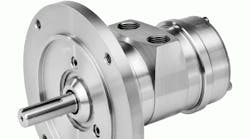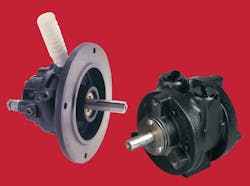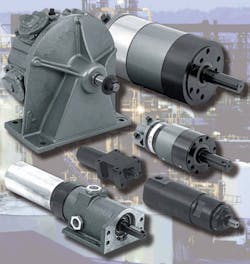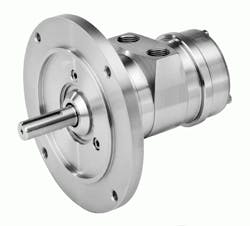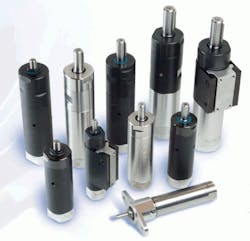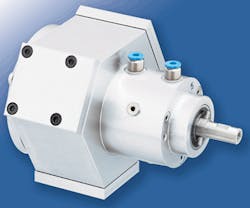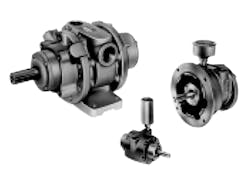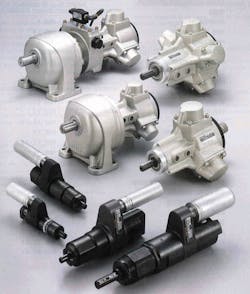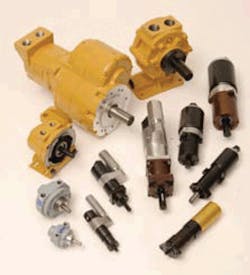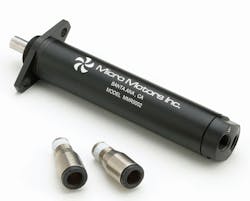This file type includes high resolution graphics and schematics when applicable.
Air motors harness the power of compressed air to generate torque and rotational motion in applications ranging from powering production machinery and rotating turntables to operating mixers and actuating valves. They’re often an engineer’s “go-to” solution for jobs an electric motor can’t handle. That’s because in many instances, air motors outperform their electric counterparts.
Advantages of air
One big advantage is safety. Because they do not require electricity and have no sparking hazards, air motors can be used in volatile atmospheres. Explosion-proof electric motors, on the other hand, require costly special housings. Air motors can also be overloaded and stalled without harm. Overloading an electric motor, however, can trip circuit breakers and damage the motor.
By their nature, air motors tolerate adverse environments well. Dust and dirt that can shorten the life of electric motors has little effect on air motors, provided the air supply sees proper filtration. Likewise, air motors withstand wet, humid, and aggressive washdown conditions. High temperatures also tend to limit the performance of electric motors. Air motors, however, are self cooling and generally perform well to 300°F and, in some cases, even higher. Cool-running air motors can also be a better choice in applications with frequent starts and stops, because electric motors must be greatly oversized to dissipate heat generated by high starting torque.
Air motors generally have a higher power density than electric motors, so they can transmit more power from the same envelope or the same power from a smaller envelope. This is especially true when loads must be driven at less than the nominal speed of the electric motor — which necessitates using an electric gearmotor or separate gear box.
Finally, electric motors typically cannot be repaired by the average maintenance technician. They must be sent to a facility that specializes in electric motor repair to be re-wound and insulated. In contrast, technicians experienced in repairing rotating equipment — such as pumps, compressors, and gear boxes — can usually work on air motors. This reduces downtime and overall maintenance costs.
Motor types
Air motors are available in different designs, but vane and piston versions are most common in industrial settings.
Piston air motors deliver high power, high starting torque, and precise speed control at low speed, making them well-suited for tasks where the motor must start under load. They usually have from two to six cylinders arranged either axially or radially within a housing. Pressure acting on pistons that reciprocate within the cylinders generates output torque.
Power developed by a piston motor depends on the inlet pressure, the number of pistons, and piston area, stroke, and speed. Speed-limiting factors are the inertia of the moving parts (which has a greater effect on radial-piston than axial-piston motors) and internal valves that control cylinder inlet and exhaust.
Radial-piston motors are robust units, typically oil-lubricated, and well-suited to continuous operation. They have the highest starting torque of any air motor. Radial-piston motors deliver torque and horsepower at relatively low speeds — under 3000 rpm – and are commonly used for driving conveyors, rotating large drums and tumblers, and for rotating positive-displacement pumps.
Axial-piston motors are more compact than their radial-piston counterparts, making them suited for mounting in close quarters. Their design is more complex and costly than vane motors, but they deliver maximum power at much lower speeds than vane motors can. Axial-piston motors also offer the ability to precisely control speed.
Rotary vane motors normally deliver low to medium power. Simple and compact vane motors are an excellent option in applications that require a high-speed, low torque power source. They most often drive portable power tools but are used in a host of other applications as well.
Vane motors have axial vanes fitted into radial slots running the length of a rotor, which mounts eccentric with the bore of the motor’s housing. The vanes are biased to seal against the housing interior wall. Torque develops from pressure acting on one side of the vanes. Torque at the output shaft is proportional to the exposed vane area, pressure, and the distance (moment arm) from the rotor center line to the center of the exposed vane. Vane motors operate at speeds from 100 to more than 25,000 rpm and deliver more power per pound than piston air motors. Though many require lubricated air, more and more are designed to operate non-lubricated to serve critical applications and address environmental concerns.
Safe power transmission
ATEX certified
Smart sensor regulates speed
This can cause problems, say in an agitator or mixer that needs a constant speed for accurate production. A change in the mixture’s viscosity or its volume in the container can cause an undesirable speed change.
A speed regulator from Deprag overcomes this issue. A non-contact speed sensor mounts between the vane air motor and its gearing, monitors the motor’s speed, and sends the data to the air motor circuit’s regulator. Any variation between actual and required speed commands a special proportional valve to actuate, which regulates air flow to the motor and, therefore, output speed.
The regulator was originally used with the company’s model 67-028R stainless-steel air motor on a chemical agitator. The nominal speed of the 1200-W motor is 1250 rpm, no-load speed is 2500 rpm, and nominal torque is 9.2 Nm, based on an operating pressure of 6 bar. Although mixtures in the agitator range in viscosity from 1 to 300 mPas, the regulator maintains motor speed within ±5 rpm—and readjusts the speed when loads change within 2 sec.
he regulator can be used across Deprag’s complete product range, even at speeds to 80,000 rpm.
Click here to read an article describing an application using this product.
Deprag North America Inc., (800) 433-7724, www.depragusa.com.
Vane and piston units
Stainless steel motors
Lube free vane units
Motors for food processing
Air-powered gear motors
Vane and radial-piston motors
200+ motors
Mini motors
This file type includes high resolution graphics and schematics when applicable.
